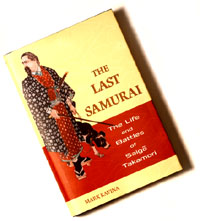After
sitting in a darkened theater watching the saga of the fictional
samurai leader Katsumoto unfold on screen, Associate Professor
of Japanese History Mark Ravina sips coffee at a nearby café
and carefully considers his reaction to the cinematic version
of The Last Samurai.
“I
liked it more than I thought I would,” Ravina says. “I
might go see it again.”
Pause.
“Of
course,” he says, “parts of the movie are just all
wrong, historically.”
Ravina
should know–he spent years researching and writing a just-published
biography, The Last Samurai: The Life and Battles of Saigo
Takamori (2004, John Wiley and Sons), about the samurai
leader who inspired the movie.
“I
first heard that the movie was about the samurai rebellion [in
1877]. Then I learned more about it and I couldn’t believe
it,” he says. “Someone was making a movie about my
guy! I was stunned.”
 Although
Ravina’s book and the movie were independent projects,
he has enjoyed a flurry of press attention and book sales as
a result of the fortuitous timing, and has appeared on CNN,
the History Channel, and National Public Radio.
Although
Ravina’s book and the movie were independent projects,
he has enjoyed a flurry of press attention and book sales as
a result of the fortuitous timing, and has appeared on CNN,
the History Channel, and National Public Radio.
“Comparing
history’s version and Hollywood’s version is like
comparing veal piccata and key lime pie. They can both be delicious
in their own way,” Ravina says. “I’m not going
to criticize the movie too much–it got me on TV.”
But
George Hisaeda, consul general of Japan, has a different take
on his friend’s newfound fame. “Thanks to the publishing
of Mark’s book, I believe the number of moviegoers has
increased,” said Hisaeda, who visited Emory in February
for the presentation of the Fukyuban edition of the Koji Ruien.
Friends
of the Emory Libraries purchased the fifty-one-volume historical
encyclopedia of Japanese life and culture for the Asian Studies
collection of the Woodruff Library.
Ravina,
chair of the East Asian Studies program, became fascinated by
the legend of Saigo Takamori in graduate school at Stanford,
while researching nineteenth-century Japan’s transition
from a feudal to a modern society. “Saigo personified that
shift,” he says. “He was caught between two political
systems, two social structures.”
Saigo
Takamori was born into poverty in 1827, the son of a tax official
who was a low-ranking urban samurai and his wife, the daughter
of a local samurai. Takamori went on to became one of Japan’s
most honored warriors, a sentimental favorite of the people
for his towering stature (he was six feet tall), courage, charisma,
and humility.
“He
didn’t order people to bow before him,” Ravina says.
“He lived with such honor that people were overcome with
respect for him.”
In
1867, at the request of the emperor, Takamori and a group of
samurai warriors seized control of the Imperial Palace in Kyoto
and restored the Meiji Empire, ending 265 years of rule by the
feudalistic Tokugawa shogunate. Ironically, in their drive to
modernize Japan, the Meiji emperor and his advisers soon abolished
all samurai privileges, including their ancient right to carry
swords.
“The
new Japan that Saigo helped create then stripped the samurai
of all that made them samurai–tradition, honor, glory,
and feudal privilege,” Ravina says.
Takamori,
who had been given command of the Imperial Guard, Japan’s
national army, became dismayed and eventually resigned from
the government to return to his native Satsuma, where he opened
a military academy for former samurai warriors.
“He
didn’t want to rise in rebellion, but he didn’t want
to betray his followers either,” Ravina says. “Saigo
was a traditionalist in much more subtle ways than the movie
was able to show–he supported traditional morality versus
the profit motive. He didn’t speak English, as he did in
the movie, but he did have an appreciation for some Western
things. He just thought the changes had gone too far.”
Eventually,
Takamori led some thirty thousand disgruntled samurai in a seven-month-long
rebellion in which he and most of his followers were killed.
While that bloody confrontation signaled the end of the samurai
class, the samurai lifestyle is glorified in contemporary Japan
much as the Wild West is romanticized in America.
“Modern
Japanese associate the samurai tradition with clarity and singlemindedness
of purpose,” Ravina says. “Friends tell me the movie
has been well-received in Japan, and I can see why. Basically,
it’s a Japanese western– Jidaigeki–a period
piece.”
In
The Last Samurai, written and directed by Edward Zwick and
Marshall Herskovitz of thirtysomething fame, Katsumoto
teaches Captain Nathan Algren (played by Tom Cruise) the nobility
of the samurai lifestyle. Algren, a disillusioned Civil War
hero, had been hired by the Japanese emperor to train the Imperial
Army in the use of modern weapons. After being captured by the
samurai and living among them, Algren ends up fighting with
the rebels against the army.
“The
Tom Cruise character is about 80 to 90 percent fictional,”
Ravina says. “It’s the old device of bringing American
audiences into foreign stories by having an American character
advance the plot. There is no doubt, though, that Katsumoto
was inspired by Saigo.”
After
Takamori’s death in battle, followers cut off his head
and hid it in an attempt to prevent the ceremonial “presentation
of severed heads.” Ravina’s book, in fact, opens with
the question: “Where was Saigo Takamori’s head? For
one frantic morning in 1877 this question consumed the Japanese
government.”
While
legend has Takamori undertaking ritual suicide on the battlefield,
historical records show he was paralyzed by a bullet and would
have been unable to do so.
Even
so, both the modern movie and wood block prints that artists
drew of Takamori’s death at the time show him committing
seppuku, the honorable death for all warriors who have been
defeated.
“Of
course, they made it all up,” Ravina says. “Then,
as now, they gave the people the ending they wanted.”–M.J.L.